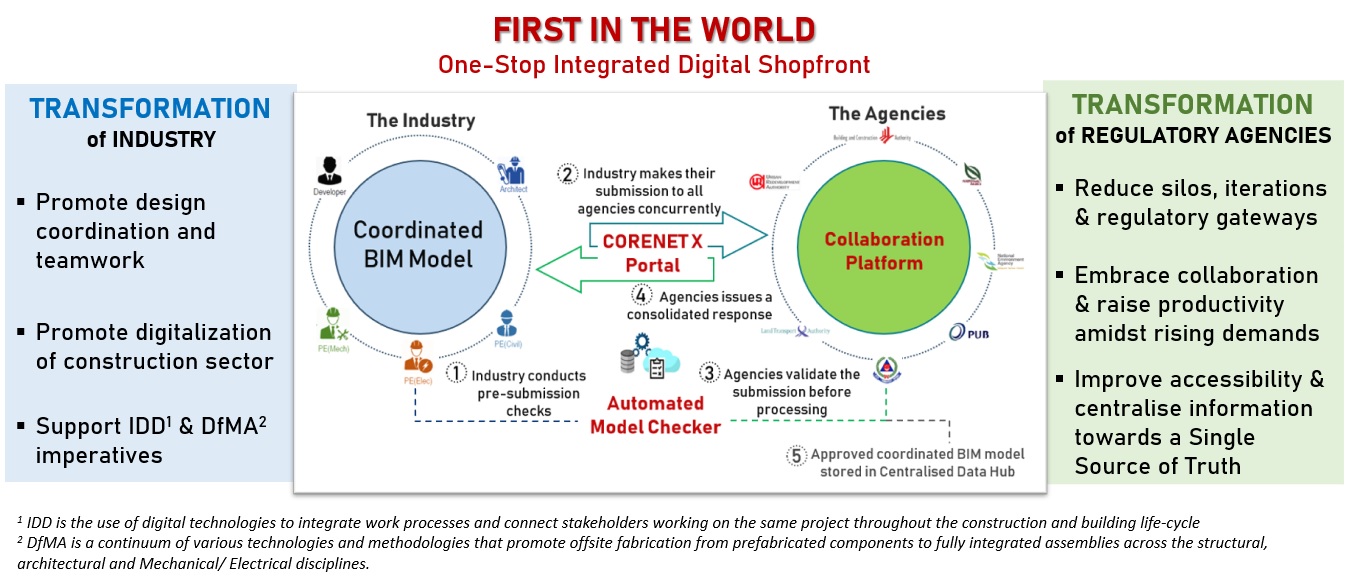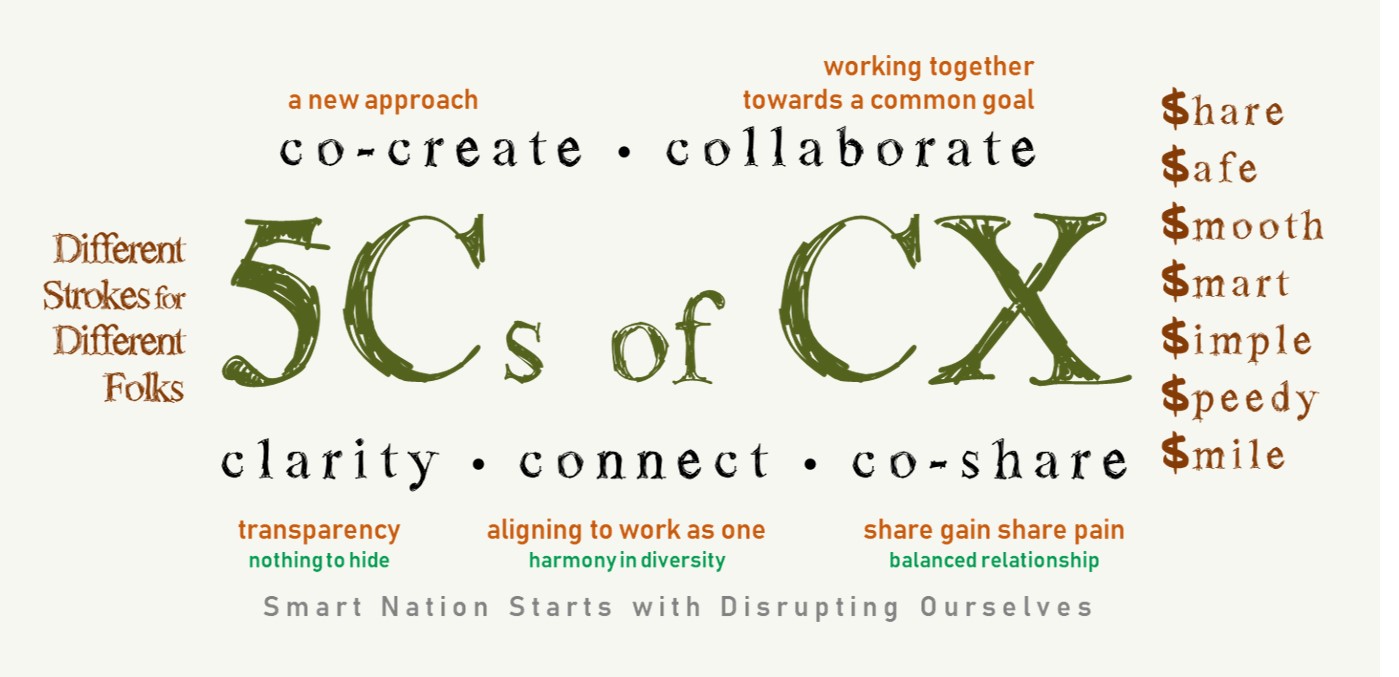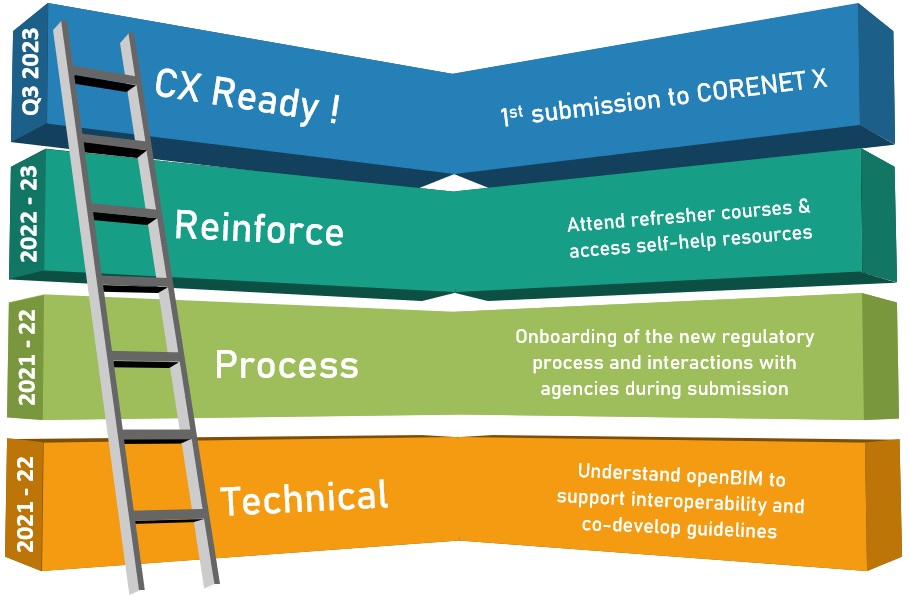Overview of CORENET X
CORENET X is an innovative digitalisation and technology-driven platform set to revolutionise the regulatory approval process for building works in Singapore and redefine Government-to-Business interactions as a One Stop Integrated Digital Shopfront. Initiated in 2018 and soft-launched on 18 Dec 2023, this cutting-edge system leverages Building Information Modelling (BIM) and automation to create a seamless, integrated experience for industry professionals.

CORENET X aims to promote greater collaboration and productive workflows for both the industry and public agencies, complementing ongoing efforts on Integrated Digital Delivery (IDD), which is a key component of the Built Environment Industry Transformation Map.
 | Industry-Agency Co-Creation More than 100 professionals from the public and private sectors embarked
on a co-creation journey to redesign the envisaged future regulatory
process for building works, kickstarting the development of CORENET X. |
 | Redefined Processes The transformation of current regulatory approval workflows from
agency-centric to customer-centric will reduce the over 20 approval stages across 7 regulatory agencies into 3 key submission
milestones. Find out more here. |
 | Technological Enablers Through an industry-facing portal, CORENET X will utilize technological
enablers to bring about collaboration, automation and interoperability.
|
A Service Journey is a Whole-of-Government movement to redesign processes and services through a user-centric approach, in order to deliver services that are easy to use, seamless and relevant.
The current regulatory processes have been largely in place for
decades. While we can make incremental changes to the processes to
facilitate ongoing projects, we see the opportunity (and an increasing
imperative) to do something more transformative. This is also in line
with the push for Integrated Digital Delivery (IDD) and the use of smarter digital tools to improve productivity while enhancing quality.
In late 2018, the agencies and industry first came together to map out
the current service blueprint, understand the associated pain-points,
gaps etc, before proceeding to the next stage. Facilitated by GovTech,
we held a "Visioning Workshop" with senior leaders in the built
environment industry to re-imagine and envision what regulatory
processes can be like in the near future.
In this co-creation effort, about 60 firms were represented, involving more than 100 professionals from the public and private sectors, including the TAC presidents of REDAS, SIA, ACES, IES, SCAL and SISV.

What's next after the CORENET X Service Journey?
We will adopt 3 strategies to progressively onboard our industry stakeholders onto CORENET X:
- Ensure industry is aware of the vision of CORENET X, its benefits and how it will impact them.
- Keep the industry updated of the latest development, upcoming events and downloadable resources through our website.
- We had organised a series of introductory webinars on CORENET X. Click here for the materials on past and upcoming webinars.
- Industry and Agencies to collaborate together to share ideas on how CORENET X can be refined and improved.
- We recently kickstarted the CORENET X Industry Community of Practice (COPr), an initiative which brings together like-minded industry practitioners and provides a platform for focus group discussions on specific topics related to the development of CORENET X. Currently, there are 37 firms in the COPr, as it continues to expand.
- We are also working closely with industry project teams on the pilot developments of our new BIM-enabled technologies.
- We have started a series of IFC webinars, jointly held with key BIM software developers. Please find out more info and self-help resources from the webinars in our IFC webpage.
- The first phase of industry training has kick-started since August 2022, focusing on IFC+SG. Please click here for more information and course availabilities.

openBIM Format
- The openBIM format, which would be platform-neutral, is being adopted to enable the industry to continue using the software of their choice to design and coordinate.
- To find out more about more about the Industry Foundation Classes (IFC) openBIM format, including export and how it will be used in future CORENET submissions, go to this link.
Automated Model Checker
- Improves the efficiency of code checking and enables self-checking by consultants prior to submission.
- This upfront validation will aid industry and agencies in checking for regulatory compliance and improve the accuracy and consistency in code interpretation.
- Under development to verify straightforward regulatory requirements, such as those related to geometric and spatial aspects of building elements and spaces, across all 3 key disciplines (Architectural, Civil and Structural, Mechanical and Electrical Engineering).
- Concurrently, potential areas for rules harmonization by the agencies are identified, and agencies are also in collaboration with industry partners to develop model preparation guidelines.
Collaboration Platform (for inter-agency collaboration)
- Aims to transform the current way agencies review plans, bringing agencies together to concurrently access the same coordinated BIM model. Agencies will then collaborate within the same Collaboration Platform, and provide a coordinated response to the industry.
- Uses technology to improve efficiency and overcome tedious work, with capabilities to identify amendments between submissions, thus eliminating massive industry efforts in preparing amendment plans.
- Enables greater collaboration and clearer communication among agencies and with the industry.
- BIM Viewer (for industry use)
- Today, QPs need to prepare different sets of plans for different agencies. Leveraging technology, QPs will prepare one coordinated model and agencies will extract relevant information. This reduces the need for manual annotations on plans.
- The BIM Viewer is one of the key functionalities of the key platform supporting CORENET X. It will bring about 3 key features for the industry:
The BIM Viewer will allow the QPs to preview their models prior to
submissions and incorporate auto-checking capabilities from the
Automated Model Checker.
Today's amendment plans require QPs to prepare the submission
highlighting deviations from earlier approved submissions. This process
is currently carried out by QPs manually. Going forward, QPs will only
need to submit the amended model. The platform will allow model
comparison with the previously approved model and identify the
deviations automatically.
Today's Written Direction and comments from agencies are provided in a list to the QPs. Leveraging technology, the comments will also be provided in the BIM Collaboration Format (BCF), which allows tracking and tagging of comments directly to the BIM model. This aims to improve the current communication between industry and agencies.